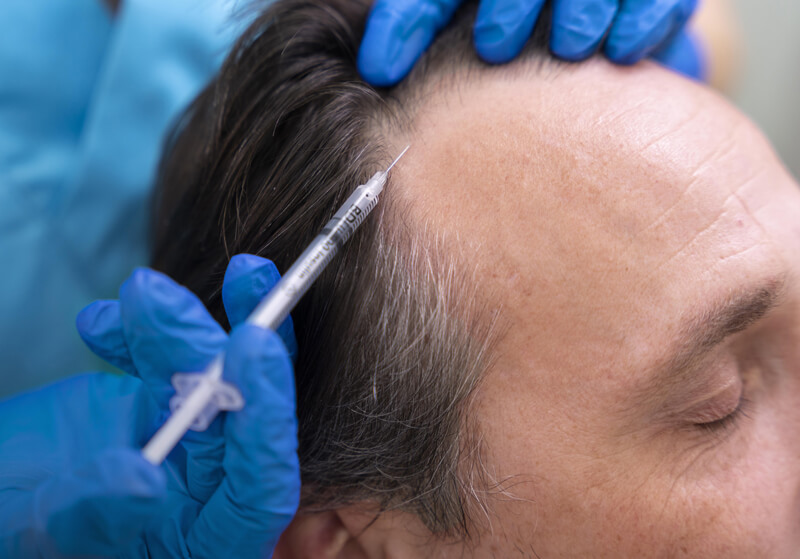
Have you ever stared at your hairline in the mirror and felt a pang of worry? You’re not alone. By the time most men hit their mid‑30s, thinning hair is just part of the story. Women notice it too, often around the same age. Platelet-rich plasma, or PRP, is gaining buzz as a gentle, non‑surgical way to wake up sleepy follicles and get hair growing again. Let’s dive deep into the details n PRP Therapy.
What Is PRP Therapy?
Imagine your blood as a mini factory. It’s busy carrying oxygen with red blood cells, and platelets are like little repair squads. In PRP therapy, we draw a small sample of blood—about two tablespoons—and spin it in a centrifuge machine. That separates the platelets into a concentrated “shot” of healing power. We then inject that into your scalp where hair is thinning.
In everyday terms: It’s like giving your scalp a natural energy drink with no additives, just your own cells doing the work.
The Science—But in Simple Terms
- We Draw Your Blood
A quick pinch in the arm, just like any blood test. - We Spin It
Ten minutes in the centrifuge, and voilà—you get a thick layer of platelets at the top. - We Inject the Good Stuff
Tiny needles, targeted zones. You might feel tiny taps, but most people say it’s more surprising than painful.
Those platelets release “growth factors.” Think of them as tiny coaches telling your hair follicles to get back in the game.
Why People Love PRP for Hair?
| Why PRP? | What You’ll Notice |
| All‑Natural | No chemicals, no surprises—just your own healing powers. |
| Quick & Easy | About an hour in the clinic. You’re back to work same day. |
| Little to No Downtime | A bit of redness or soreness—no big deal. |
| Looks Natural | Hair grows in on its own schedule. No helmet‑hair effect. |
| Mixes Well | You can use it alongside creams, lasers, even transplants. |
Is PRP Right for You?
PRP tends to shine when your hair loss is still in the early to middle stages. If you’re seeing the Norwood II-IV pattern (that’s mainly for men) or Ludwig I–II for women, PRP could give your follicles a second wind.
Real situation: Sarah, 32, noticed widening part lines but didn’t want a transplant yet. After three PRP sessions with Dr. Sezgin, her part looked noticeably fuller—and her morning coffee chats with friends became all about her glow, not her hair worries.
Your First Visit—Step by Step
- Chat & Check‑Up
Dr. Sezgin asks about your health, scalp issues, and goals. - Blood Draw & Spin
While the machine does its work, you can listen to calm music in our private room. - Numbing & Injection
A light numbing cream goes on. Then Dr. Sezgin uses fine needles to place PRP where it’s needed most. - Quick Scalp Massage
Just a minute to help that PRP spread. Then you’re done—no bandages needed. - Home Care Tips
We’ll remind you to skip heavy sweating and harsh dyes for a couple of days.
What Happens Next?
- Day 1–2: You might have a bit of redness, like you’ve spent too much time in the sun.
- Week 1: Some people feel their scalp is tighter—like a gentle wake‑up call.
- Week 6–12: Subtle new hair sprouts start to peek through. Friends might ask, “Did you try a new shampoo?”
- Month 4–6: Most folks see noticeable thickening and less shedding. Time to stock up on new brushes!
Possible Side Effects & Safety
- Common: Mild soreness, tiny bruises, slight headache.
- Rare: Infection or prolonged swelling—very uncommon in a clean, clinic‑grade setting.
- Why Expertise Matters: As the first Turkish surgeon in the International Society of Hair Restoration Surgery, Dr. Sezgin follows top‑tier protocols. He treats only one patient per day, so each step is precise and personalized.
Combining PRP with Other Treatments
Many patients wonder if PRP can stand alone or if it pairs well with other hair‑restoration methods. The good news? PRP is highly versatile. You might combine it with topical solutions like minoxidil or finasteride to maximize results. Some clients add low‑level laser therapy sessions for an extra boost in follicle stimulation. Even those planning future hair transplants find PRP helpful: it preps the scalp by improving blood flow and tissue quality, so grafts take more readily. Always discuss your full treatment plan with Dr. Sezgin—he’ll tailor a schedule that blends PRP and complementary therapies for the most natural, long‑lasting outcome.
Frequently Asked Questions
- Does PRP Hurt?
It’s more odd than painful. The numbing cream takes care of most of the sting. - How Many Sessions?
We usually plan three sessions, spaced about a month apart. - Will I Need More Later?
A touch‑up every 4–6 months is ideal to keep things going.
Meet Dr. Çağatay Sezgin
Dr. Sezgin isn’t just another hair restoration surgeon. He’s the first Turkish board‑certified member of the ISHRS, with over 25 years devoted solely to hair, beard, and eyebrow transplants. He spends every day on one patient—no rushing, no assembly‑line care. That focus means you get his full attention, expertise, and a plan built just for you.
Ready to give your hair a fresh start?
Book your consultation with Dr. Sezgin today. Let his decades of experience guide your journey back to confidence—and fuller, healthier hair.








